High Foot Traffic Power Harvesting Technologies and Challenges: A Review and Possible Sustainable Solutions for Al-Haram Mosque
Abstract
:1. Introduction
2. Methodology
3. Energy Harvesting
3.1. Energy Harvesting Material: t-TENGs
3.2. Energy Harvesting Material: Piezoelectric
3.3. Energy Harvesting Material: Cellulosic
3.4. Energy Harvesting Material: MXene-Based Materials
3.5. Summary of Energy Harvesting
4. Design
- Multimodal Energy Harvesting for High Efficiency
- Broader Frequency Range Through d31 and d36 Modes
- Better Structural Design with Coupled Bending–Torsion Mechanics
- Durability and Low Maintenance
- Scalable Design for Large Surfaces
- Real-Time Data Collection and IoT Integration
5. Output Voltage and Feasibility
6. Challenges
6.1. Low Power Output
6.2. Unstable Output
6.3. Mechanical Durability
6.4. Dependence on Environmental Conditions and Load Resistance Sensitivity
6.5. Design Complexity and Sensitivity and Energy Loss in Crinkle Washers
7. The Case Study
- (a)
- It hosts millions of pedestrians, which presents a significant opportunity for kinetic-electricity conversion. Moreover, foot traffic is consistent, meaning the large number of people (thousands at any given time) is sufficient to provide a steady flow of electricity.
- (b)
- The site consumes a tremendous amount of electricity, and kinetic energy is currently being wasted.
- (c)
- It is a challenging location for developing kinetic energy harvesting systems that are capable of remaining sustainable while enduring extreme conditions, such as high temperatures, continuous use, and frequent folding and cleaning.
7.1. Background
7.2. Primary Energy Sources
7.3. Sustainability and Future Directions for Al-Haram
- (a)
- (b)
- Cooling Innovations: To address the high energy demands associated with cooling, the mosque may consider adopting district cooling systems or high-efficiency chillers to lower electricity usage [113]. Additionally, advanced air distribution and heat exchange systems could help manage cooling more efficiently [87].
- (c)
- Energy Storage Solutions: Battery energy storage could enhance the integration of renewable sources, especially solar power, by storing excess energy generated during the day [100]. This stored energy can then be utilized during peak demand periods or at night when solar energy is unavailable.
7.4. Kinetic Energy Harvesting Materials Assessment
7.4.1. t-TENGs Materials
7.4.2. Piezoelectric Materials
7.4.3. Cellulosic Materials
- (a)
- A flexible, breathable, and environmentally friendly base layer.
- (b)
- A substrate or matrix for embedding piezoelectric or triboelectric components.
- (c)
- An active material through chemical modification.
7.4.4. MXene-Based Materials
8. Conclusions
Author Contributions
Funding
Data Availability Statement
Conflicts of Interest
References
- Islam, E.; Abdullah, A.M.; Chowdhury, A.R.; Tasnim, F.; Martinez, M.; Olivares, C.; Lozano, K.; Jasim Uddin, M. Electromagnetic-triboelectric-hybrid energy tile for biomechanical green energy harvesting. Nano Energy 2020, 77, 105250. [Google Scholar] [CrossRef]
- Jureczko, M.; Filas, J.; Mrówka, M. The application of piezoelectric materials to convert kinetic energy into electrical energy. Int. Sci. J. Achiev. Mater. Manuf. Eng. 2023, 121, 231–237. [Google Scholar] [CrossRef]
- Selim, K.K.; Smaili, I.H.; Yehia, H.M.; Ahmed, M.M.R.; Saleeb, D.A. Piezoelectric Sensors Pressed by Human Footsteps for Energy Harvesting. Energies 2024, 17, 2297. [Google Scholar] [CrossRef]
- Serrano, M.; Larkin, K.; Tretiak, S.; Abdelkefi, A. Piezoelectric Energy Harvesting Gyroscopes: Comparative Modeling and Effectiveness. Energies 2023, 16, 2000. [Google Scholar] [CrossRef]
- Asry, M.; Maisarah, A.; Mustafa, F.; Sim, S.Y.; Ishak, M.; Mohamad, A. Study on footstep power generation using piezoelectric tile. Indones. J. Electr. Eng. Comput. Sci. 2019, 15, 593–599. [Google Scholar] [CrossRef]
- Yeboah, D.; Quainoo, S.A.; Brew, A. Wilma Hybrid electricity generation using solar energy and kinetic energy of players’ footsteps—A case study: Tarkwa Akoon soccer park, Ghana. Int. J. Ambient Energy 2023, 44, 2347–2361. [Google Scholar] [CrossRef]
- Li, W.; Liu, X.; Wang, Y.; Peng, L.; Jin, X.; Jiang, Z.; Guo, Z.; Chen, J.; Wang, W. Research on high sensitivity piezoresistive sensor based on structural design. Discov. Nano 2024, 19, 88. [Google Scholar] [CrossRef]
- Son, J.-h.; Kim, H.; Choi, Y.; Lee, H. 3D printed energy devices: Generation, conversion, and storage. Microsyst. Nanoeng. 2024, 10, 93. [Google Scholar] [CrossRef]
- Galletta, S.; Mazzù, S.; Naciti, V.; Paltrinieri, A. A PRISMA systematic review of greenwashing in the banking industry: A call for action. Res. Int. Bus. Financ. 2024, 69, 102262. [Google Scholar] [CrossRef]
- Moher, D.; Liberati, A.; Tetzlaff, J.; Altman, D.G. Preferred reporting items for systematic reviews and meta-analyses: The prisma statement. J. Clin. Epidemiol. 2009, 62, 1006–1012. [Google Scholar] [CrossRef]
- Ghazanfarian, J.; Mohammadi, M.M.; Uchino, K. Piezoelectric energy harvesting: A systematic review of reviews. Actuators 2021, 10, 312. [Google Scholar] [CrossRef]
- Osorio, M.A.A.; Concepcion, R.; Dadios, E. Multi-Source Energy Harvesting Systems: A PRISMA Approach on Energy Sources and Optimization Strategies. In Proceedings of the IEEE 15th International Conference on Humanoid, Nanotechnology, Information Technology, Communication and Control, Environment, and Management (HNICEM), Coron, Philippines, 19–23 November 2023; pp. 1–6. [Google Scholar]
- Amran, Y.A.; Amran, Y.M.; Alyousef, R.; Alabduljabbar, H. Renewable and sustainable energy production in Saudi Arabia according to Saudi Vision 2030; Current status and future prospects. J. Clean. Prod. 2020, 247, 119602. [Google Scholar] [CrossRef]
- Zhang, L.; Zheng, H.; Liu, B.; Liang, Q.; Li, K.; Liu, J.; Chen, W. A piezoelectric energy harvester for multi-type environments. Energy 2024, 305, 132218. [Google Scholar] [CrossRef]
- Akinaga, H.; Fujita, H.; Mizuguchi, M.; Mori, T. Focus on advanced materials for energy harvesting: Prospects and approaches of energy harvesting technologies. Sci. Technol. Adv. Mater. 2018, 19, 543–544. [Google Scholar] [CrossRef]
- Fang, L.H.; Abd Rahim, R.; Romli, M.I.F.; Nordin, J.M.; Zain, A.S.M.; Mujahidin, N.M.D.Z. Development of Highly Efficient Hybrid KineticSolar Energy Harvesting System. In Proceedings of the 9th International Conference on Computer and Communication Engineering (ICCCE), Kuala Lumpur, Malaysia, 15–16 August 2023. [Google Scholar]
- Gaikwad, P.S.; Dudhagi, N.S.; Khurd, S.R.; Madur, P.V.; Pawar, P.S. Hybrid Power Generation using Solar PV and Piezoelectric Transducer System. Int. J. Res. Appl. Sci. Eng. Technol. (IJRASET) 2020, 8, 31959. [Google Scholar] [CrossRef]
- Atik, M.A.-U.-Z.; Mostakim, N.; Sarwar, N. Design and Implementation of a Prototype of Piezo Transduced Intelligent Power Management System for Efficient Street Lighting. Int. J. Eng. Manuf. 2023, 13, 25–33. [Google Scholar]
- Crawley, F.J.E.; Luo, Z. High force compression mode to Shear mode piezoelectric energy harvesting. Micro Nano Eng. 2024, 23, 100245. [Google Scholar] [CrossRef]
- Li, J.; Li, M.; Koh, J.J.; Wang, J.; Lyu, Z. 3D-printed biomimetic structures for energy and environmental applications. DeCarbon 2024, 3, 100026. [Google Scholar] [CrossRef]
- Liu, S.; Qing, W.; Zhang, B.; Liao, S.; Zhu, Y.; Wei, K.; Zhao, L.; Deng, L.; Zou, H. Hierarchical flexible composite with enhanced magnetoelectric response for energy harvesting. J. Alloys Compd. 2024, 1003, 175618. [Google Scholar] [CrossRef]
- Naifar, S.; Kanoun, O.; Trigona, C. Energy Harvesting Technologies and Applications for the Internet of Things and Wireless Sensor Networks. Sensors 2024, 24, 4688. [Google Scholar] [CrossRef]
- Barhoumi, E.M.; Okonkwo, P.C.; Zghaibeh, M.; Belgacem, I.B.; Alkanhal, T.A.; Abo-Khalil, A.G.; Tlili, I. Renewable energy resources and workforce case study Saudi Arabia: Review and recommendations. J. Therm. Anal. Calorim. 2020, 141, 221–230. [Google Scholar] [CrossRef]
- Koç, M.; Tatardar, F.; Musayeva, N.N.; Guluzade, S.; Sari, A.; Paralı, L. The piezoelectric properties of three-phase electrospun PVDF/PZT/ Multiwalled Carbone Nanotube composites for energy harvesting applications. J. Alloys Compd. 2024, 1003, 175578. [Google Scholar] [CrossRef]
- Alsharif, M.H.; Kim, S.; Kuruoğlu, N. Energy harvesting techniques for wireless sensor networks: A systematic literature review. Energy Strategy Rev. 2025, 57, 101617. [Google Scholar]
- Aguarin, T.A.D.C.; Balcita, V.R.G.; Escober, A.M.C.; Muñoz, J.B.B. Pow3rSteps: Designing a Portable Piezoelectric-Triboelectric-Electromagnetic Triple Hybrid Floor Mat Generator; DLSU Senior High School: Manila, Philippines, 2023. [Google Scholar]
- Aguarin, T.A.D.C.; Balcita, V.R.G.; Escober, A.M.C.; Muñoz, J.B.B. Portable Piezoelectric-Triboelectric-Electromagnetic Triple Hybrid Floor Mat Generator. In Proceedings of the 2023 IEEE 15th International Conference on Humanoid, Nanotechnology, Information Technology, Communication and Control, Environment, and Management (HNICEM), Coron, Philippines, 19–23 November 2023. [Google Scholar]
- Wang, Z.L. Triboelectric Nanogenerators as New Energy Technology for Self-Powered Systems and as Active Mechanical and Chemical Sensors. ACS Nano 2013, 7, 9533–9557. [Google Scholar] [CrossRef] [PubMed]
- Wu, C.; Wang, A.C.; Ding, W.; Guo, H.; Wang, Z.L. Triboelectric nanogenerator: A foundation of the energy for the new era. Adv. Energy Mater. 2019, 9, 1802906. [Google Scholar] [CrossRef]
- Chen, G.; Li, Y.; Bick, M.; Chen, J. Smart textiles for electricity generation. Chem. Rev. 2020, 120, 3668–3720. [Google Scholar] [CrossRef]
- Pang, Y.; Cao, Y.; Derakhshani, M.; Fang, Y.; Wang, Z.L.; Cao, C. Hybrid Energy-Harvesting Systems Based on Triboelectric Nanogenerators. Matter 2021, 4, 116–143. [Google Scholar] [CrossRef]
- So, M.Y.; Xu, B.; Li, Z.; Lai, C.L.; Jiang, C. Flexible corrugated triboelectric nanogenerators for efficient biomechanical energy harvesting and human motion monitoring. Nano Energy 2023, 106, 108033. [Google Scholar] [CrossRef]
- Lin, H.; Liua, Y.; Chena, S.; Xua, Q.; Wang, S.; Hu, T.; Pan, P.; Wang, Y.; Zhang, Y.; Li, N.; et al. Seesaw structured triboelectric nanogenerator with enhanced output performance and its applications in self-powered motion sensing. Nano Energy 2019, 65, 103944. [Google Scholar] [CrossRef]
- Chen, B.; Tang, W.; Wang, Z.L. Advanced 3D printing-based triboelectric nanogenerator for mechanical energy harvesting and self-powered sensing. Mater. Today 2021, 50, 224–238. [Google Scholar] [CrossRef]
- Radhakrishnan, S.; Joseph, S.; Jelmy, E.J.; Saji, K.J.; Sanathanakrishnan, T.; John, H. Triboelectric nanogenerators for marine energy harvesting and sensing applications. Results Eng. 2022, 15, 100487. [Google Scholar] [CrossRef]
- Xing, F.; Jie, Y.; Cao, X.; Li, T.; Ning, W. Natural triboelectric nanogenerator based on soles for harvesting low-frequency walking energy. Nano Energy 2017, 42, 138–142. [Google Scholar] [CrossRef]
- Pang, Y.; Zhu, X.; Lee, C.; Liu, S. Triboelectric nanogenerator as next-generation self-powered sensor for cooperative vehicle-infrastructure system. Nano Energy 2022, 97, 107219. [Google Scholar] [CrossRef]
- Pu, X.; Zhang, C.; Wang, Z.L. Triboelectric nanogenerators as wearable power sources and self-powered sensors. Natl. Sci. Rev. 2023, 10, nwac170. [Google Scholar] [CrossRef] [PubMed]
- Lu, P.; Liao, X.; Guo, X.; Cai, C.; Liu, Y.; Chi, M.; Du, G.; Wei, Z.; Meng, X.; Nie, S. Gel-Based Triboelectric Nanogenerators for Flexible Sensing: Principles, Properties, and Applications. Nano Micro Lett. 2024, 16, 206. [Google Scholar] [CrossRef]
- Yang, Y.; Liu, Y.; Yin, R. Fiber/Yarn and Textile-Based Piezoresistive Pressure Sensors. Adv. Fiber Mater. 2024, 7, 34–71. [Google Scholar] [CrossRef]
- Tian, X.; Dong, S.; Yang, M.; Ng, H.; Liu, Y.; Hu, H.; Hu, T. Textile-Based Triboelectric Nanogenerators for Smart Wearable Systems: Comfort, Integration, and Application. Adv. Mater. Technol. 2022, 8, 2201294. [Google Scholar] [CrossRef]
- Babu, A.; Aazem, I.; Walden, R.; Bairagi, S.; Mulvihill, D.M.; Pillai, S.C. Electrospun nanofiber based TENGs for wearable electronics and self-powered sensing. Chem. Eng. J. 2023, 452, 139060. [Google Scholar] [CrossRef]
- Dulal, M.; Afroj, S.; Ahn, J.; Cho, Y.; Carr, C.; Kim, I.-D.; Karim, N. Toward Sustainable Wearable Electronic Textiles. ACS Nano 2022, 16, 19755–19788. [Google Scholar] [CrossRef]
- Qin, Y.; Fu, X.; Lin, Y.; Wang, Z.; Cao, J.; Zhang, C. Self-powered Internet of Things sensing node based on triboelectric nanogenerator for sustainable environmental monitoring. Nano Res. 2023, 16, 11878–11884. [Google Scholar] [CrossRef]
- Yu, Y.; Gao, Q.; Zhang, X.; Zhao, D.; Xia, X.; Wang, J.; Li, H.; Wang, Z.L.; Cheng, T. Contact-sliding-separation mode triboelectric nanogenerator. Energy Environ. Sci. 2023, 2023, 3932–3941. [Google Scholar] [CrossRef]
- Jawahar, M.; Gruteser, M.; Howard, R. Kicking Yourself Awake: Towards self-powering mats for room-level localization and occupancy detection. In Proceedings of HotMobile ’21: Proceedings of the 22nd International Workshop on Mobile Computing Systems and Applications, Virtual, UK, 24–26 February 2021. [Google Scholar]
- Hong, Y.; Liu, S.; Yang, X.; Hong, W.; Shan, Y.; Wang, B.; Zhang, Z.; Yan, X.; Lin, W.; Li, X.; et al. A bioinspired surface tension-driven route toward programmed cellular ceramics. Nat. Commun. 2024, 15, 5030. [Google Scholar] [CrossRef]
- Huang, Z.-X.; Li, L.-W.; Huang, Y.-Z.; Rao, W.-X.; Jiang, H.-W.; Wang, J.; Zhang, H.-H.; He, H.-Z.; Qu, J.-P. Self-poled piezoelectric polymer composites via melt-state energy implantation. Nat. Commun. 2024, 15, 819. [Google Scholar] [CrossRef] [PubMed]
- Abir, S.S.H.; Sharma, S.; Sharma, P.; Karla, S.; Balasubramanian, G.; Samuel, J.; Koratkar, N. Piezoelectricity in chalcogenide perovskites. Nat. Commun. 2024, 15, 5768. [Google Scholar] [CrossRef] [PubMed]
- Song, Y.; Shi, Z.; Hu, G.-H.; Xiong, C.; Akira, I.; Yang, Q. Recent advances in cellulose-based piezoelectric and triboelectric nanogenerators for energy harvesting: A review. J. Mater. Chem. A 2021, 9, 1910–1937. [Google Scholar] [CrossRef]
- Hu, S.; Han, J.; Shi, Z.; Chen, K.; Xu, N.; Wang, Y.; Yang, G. Biodegradable, super-strong, and conductive cellulose macrofibers for fabric-based triboelectric nanogenerator. Nano-Micro Lett. 2022, 14, 115. [Google Scholar] [CrossRef] [PubMed]
- Li, M.; Jie, Y.; Shao, L.-H.; Guo, Y.; Cao, X.; Wang, N.; Wang, Z.L. All-in-one cellulose based hybrid tribo/piezoelectric nanogenerator. Nano Res. 2019, 12, 1831–1835. [Google Scholar] [CrossRef]
- Luo, C.; Ma, H.; Yu, H.; Zhang, Y.; Shao, Y.; Yin, B.; Ke, K.; Zhou, L.; Zhang, K.; Yang, M.-B. Enhanced Triboelectric Nanogenerator Based on a Hybrid Cellulose Aerogel for Energy Harvesting and Self-Powered Sensing. ACS Sustain. Chem. Eng. 2023, 11, 9424–9432. [Google Scholar] [CrossRef]
- Liao, H.; Na, J.; Zhou, W.; Hur, S.; Chien, P.M.; Wang, C.; Wang, L.; Yamauchi, Y.; Yuan, Z. Enhancing energy harvesting performance and sustainability of cellulose-based triboelectric nanogenerators: Strategies for performance enhancement. Nano Energy 2023, 116, 108769. [Google Scholar] [CrossRef]
- Cheng, H.; Li, L.; Wang, B.; Feng, X.; Mao, Z.; Vancso, G.J.; Sui, X. Multifaceted applications of cellulosic porous materials in environment, energy, and health. Prog. Polym. Sci. 2020, 106, 101253. [Google Scholar] [CrossRef]
- Wang, X.; Yao, C.; Wang, F.; Li, Z. Cellulose-Based Nanomaterials for Energy Applications. Small 2018, 13, 1702240. [Google Scholar] [CrossRef] [PubMed]
- Nie, S.; Cai, C.; Lin, X.; Zhang, C.; Lu, Y.; Mo, J.; Wang, S. Chemically Functionalized Cellulose Nanofibrils for Improving Triboelectric Charge Density of a Triboelectric Nanogenerator. ACS Sustain. Chem. Eng. 2020, 8, 18678–18685. [Google Scholar] [CrossRef]
- Zhang, C.; Lin, X.; Zhang, N.; Lu, Y.; Wu, Z.; Liu, G.; Nie, S. Chemically functionalized cellulose nanofibrils-based gear-like triboelectric nanogenerator for energy harvesting and sensing. Nano Energy 2019, 66, 104126. [Google Scholar] [CrossRef]
- Zhang, M.; Xu, T.; Zhao, Q.; Liu, K.; Liang, D.; Si, C. Cellulose-based materials for carbon capture and conversion. Carbon Capture Sci. Technol. 2024, 10, 100157. [Google Scholar] [CrossRef]
- Das, K.K.; Basu, B.; Maiti, P.; Dubey, A. Kumar Piezoelectric nanogenerators for self-powered wearable and implantable bioelectronic devices. Acta Biomater. 2023, 171, 85–113. [Google Scholar] [CrossRef]
- Guan, Y.; Bai, M.; Wang, Q.; Liu, L.; Yu, S.; Kong, B.; Lv, F.; Guo, M.; Liu, G.; Li, L.; et al. A self-powered wearable piezoelectric nanogenerator for physiological monitoring based on lead zirconate titanate/microfibrillated cellulose@polyvinyl alcohol (PZT/MFC@PVA) composition. Chem. Eng. J. 2023, 460, 141598. [Google Scholar] [CrossRef]
- Guo, L.; Wang, H. Multi-physics modeling of piezoelectric energy harvesters from vibrations for improved cantilever designs. Energy 2023, 263, 125870. [Google Scholar] [CrossRef]
- Fang, S.; Ji, X.; Wang, H.; Jiang, H.; Gao, M.; Liu, H.; Liu, Y.; Cheng, B. Cellulose-based green triboelectric nanogenerators: Materials, form designs, and applications. J. Mater. Chem. A 2024, 2024, 9322–9344. [Google Scholar] [CrossRef]
- Wang, Y.; Zhang, Q.; Li, P.; Huang, J.-T. A durable and sustainable superhydrophobic surface with intertwined cellulose/SiO2 blends for anti-icing and self-cleaning applications. Mater. Des. 2022, 217, 110628. [Google Scholar] [CrossRef]
- Khan, K.; Tareen, A.K.; Iqbal, M.; Zhang, Y.; Mahmood, A.; Mahmood, N.; Shi, Z.; Ma, C.; Rosin, J.R.; Zhang, H. Recent Progress and New Horizons in Emerging Novel MXene-Based Materials for Energy Storage Applications for Current Environmental Remediation and Energy. Electrochem. Energy Rev. 2024, 7, 22. [Google Scholar] [CrossRef]
- Hart, J.L.; Hantanasirisakul, K.; Lang, A.C.; Anasori, B.; Pinto, D.; Pivak, Y.; van Omme, J.T.; May, S.J.; Gogotsi, Y.; Taheri, M.L. Control of MXenes’ electronic properties through termination and intercalation. Nat. Commun. 2019, 10, 522. [Google Scholar] [CrossRef]
- Zhang, H.; Zhang, X.; Qiu, C.; Jia, P.; An, F.; Zhou, L.; Zhu, L.; Zhang, D. Polyaniline/ZnO heterostructure-based ammonia sensor self-powered by electrospinning of PTFE-PVDF/MXene piezo-tribo hybrid nanogenerator. Chem. Eng. J. 2024, 496, 154226. [Google Scholar] [CrossRef]
- Cai, X.; Xiao, Y.; Zhang, B.; Yang, Y.; Wang, J.; Chen, H.; Shen, G. Surface Control and Electrical Tuning of MXene Electrode for Flexible Self-Powered Human–Machine Interaction. Adv. Funct. Mater. 2023, 33, 2304456. [Google Scholar] [CrossRef]
- Wang, L.; Xu, H.; Huang, F.; Tao, X.; Ouyang, Y.; Zhou, Y.; Mo, X. High-Output Lotus-Leaf-Bionic Triboelectric Nanogenerators Based on 2D MXene for Health Monitoring of Human Feet. Nanomaterials 2022, 12, 3217. [Google Scholar] [CrossRef] [PubMed]
- Madathil, N.; Potu, S.; Pani, J.; Bochu, L.; Babu, A.; Borkar, H.; Kodali, P.; Khanapuram, U.K.; Rajaboina, R.K. Enhancing Triboelectric Nanogenerators Performance with MXene–Silicone Nanocomposites: A Leap Forward in Energy Harvesting and Touch-Sensitive Technologies. ACS Appl. Electron. Mater. 2024, 6, 5563–5574. [Google Scholar] [CrossRef]
- Deng, S.; Akram, W.; Ye, X.; Zhang, L.; Yang, Y.; Cheng, S.; Fang, J. Comprehensive Insights on MXene-Based TENGs: From Structures, Functions to Applications. Nano-Micro Small 2024, 20, 2404872. [Google Scholar] [CrossRef]
- Mohan, R.; Ali, F. The future of energy harvesting: A brief review of MXenes-based triboelectric nanogenerators. Polym. Adv. Technol. 2023, 34, 3193–3209. [Google Scholar] [CrossRef]
- Bhatta, T.; Maharjan, P.; Cho, H.; Park, C.; Yoon, S.H.; Sharma, S.; Salauddin, M.; Toyabur Rahman, M.; Sohel Rana, S.; Park, J.Y. High-performance triboelectric nanogenerator based on MXene functionalized polyvinylidene fluoride composite nanofibers. Nano Energy 2021, 81, 105670. [Google Scholar] [CrossRef]
- Mankuni, A.; Varghese, S. Flexible Piezoelectric Nanogenerator Based on a Poly(vinylidene fluoride)–Ti3C2 MXene Film for Underwater Energy Harvesting. ACS Appl. Electron. Mater. 2024, 6, 4194–4203. [Google Scholar] [CrossRef]
- Zong, Y.; Wang, R.; XuRun, S.; Zhang, Z. Flexible Piezoelectric Nanogenerator Based on Cellulose Nanofibril/MXene Composite Aerogels for Low-Frequency Energy Harvesting. ACS Appl. Nano Mater. 2023, 6, 9021–9031. [Google Scholar] [CrossRef]
- Pabba, D.P.; Satthiyaraju, M.; Ramasdoss, A.; Sakthivel, P.; Chidhambaram, N.; Dhanabalan, S.; Abarzúa, C.V.; Morel, M.J.; Udayabhaskar, R.; Mangalaraja, R.V.; et al. MXene-Based Nanocomposites for Piezoelectric and Triboelectric Energy Harvesting Applications. Micromachines 2023, 14, 1273. [Google Scholar] [CrossRef] [PubMed]
- Wang, Y.; Guo, T.; Tian, Z.; Bibi, K.; Zhang, Y.-Z.; Alshareef, H.N. MXenes for Energy Harvesting. Adv. Mater. 2022, 34, 2108560. [Google Scholar] [CrossRef] [PubMed]
- Zhu, Y.; Zheng, S.; Lu, P.; Ma, J.; Das, P.; Su, F.; Cheng, H.-M.; Wu, Z.-S. Kinetic regulation of MXene with water-in-LiCl electrolyte for high-voltage micro-supercapacitors. Natl. Sci. Rev. 2022, 9, nwac024. [Google Scholar] [CrossRef] [PubMed]
- Tao, X.; Zhang, L.; He, X.; Fang, L.; Wang, H.; Zhang, L.; Yu, L.; Zhu, G. Nitrogen-Doped Porous MXene (Ti3C2) for Flexible Supercapacitors with Enhanced Storage Performance. Molecules 2022, 27, 4890. [Google Scholar] [CrossRef]
- Zhang, X.; Yang, S.; Liu, S.; Che, X.; Lu, W.; Tian, Y.; Liu, Z.; Zhao, Y.; Yang, J. Ti3C2Tx MXene-Coupled NiCo-Layered Double Hydroxide Nanosheets with Entire Contact for High-Performance Supercapacitors. ACS Appl. Energy Mater. 2022, 6, 636–643. [Google Scholar] [CrossRef]
- Safdar, S.; Anjam, N.; Muzaffar, N.; Imran, M.; Afzal, A.M.; Iqbal, M.W.; Mumtaz, S.; Almutairi, T.M.; Shahbaz, M.A.H.; Imran, H.; et al. MXene/NiCu-MOF//AC Nanocomposite Electrode: A Dual-Functional Platform for Energy Storage and Real-Time Monitoring of Monosodium Glutamate Based Sensors. ECS J. Solid State Sci. Technol. 2024, 13, 111001. [Google Scholar] [CrossRef]
- Rahman, U.U.; Humayun, M.; Ghani, U.; Usman, M.; Ullah, H.; Khan, A.; Khan, A. Mxenes as emerging materials: Synthesis, properties, and applications. Molecules 2022, 27, 4909. [Google Scholar] [CrossRef]
- Ding, L.; Zheng, M.; Xiao, D.; Zhao, Z.; Xue, J.; Zhang, S.; Wang, H. Bioinspired ti3c2txmxene-based ionic diode membrane for high-efficient osmotic energy conversion. Angew. Chem. Int. Ed. 2022, 61, e202206152. [Google Scholar] [CrossRef]
- Chang, L.; Zhang, T.; Wang, F.; Ma, H.; Xie, W.; Ding, T.; Xiao, X. Cation-selective mo2tic2t x mxene membrane for osmotic energy harvesting. 2D Mater. 2022, 10, 014009. [Google Scholar] [CrossRef]
- Hong, S.; El-Demellawi, J.K.; Lei, Y.; Liu, Z.; Al Marzooqi, F.; Arafat, H.A.; Alshareef, H.N. Porous ti3c2tx mxene membranes for highly efficient salinity gradient energy harvesting. ACS Nano 2022, 16, 792–800. [Google Scholar] [CrossRef]
- Paosangthong, W.; Torah, R.; Beeby, S. Recent progress on textile-based triboelectric nanogenerators. Nano Energy 2019, 55, 401–423. [Google Scholar] [CrossRef]
- Ba Yashout, M.M.S.B.; AI-Humairi, S.N.S.; Abdullah, M.I.; Zulkipli, M.A. Magic Mat: Design A Smart Power Generation System Using Piezoelectric Mechanisms. In Proceedings of the IEEE 9th Conference on Systems, Process and Control (ICSPC 2021), Melaka, Malaysia, 10–11 December 2021. [Google Scholar]
- Çelik, G.; Abut, Y. Development of Accessible Pedestrian Signals (APS) with Piezoelectricity. In Proceedings of the 1st International Conference on Frontiers in Academic Research, Konya, Turkey, 18–21 February 2023. [Google Scholar]
- Cabading, C.S.; Natividad, J.F.; Santiago, R.V. Design of A Hybrid Renewable Energy System with IoT Monitoring and Battery Management. In Proceedings of the 2 IEEE 14th International Conference on Humanoid, Nanotechnology, Information Technology, Communication and Control, Environment and Management, Boracay Island, Philippines, 1–4 December 2022. [Google Scholar]
- Walden, R.; Aazem, I.; Babu, A.; Pillai, S.C. Textile-Triboelectric nanogenerators (T-TENGs) for wearable energy harvesting devices. Chem. Eng. J. 2023, 451, 138741. [Google Scholar] [CrossRef]
- Koszewnik, A. Assessment of parameters of the vibration-based energy harvesting system located in the micro-power generator. Acta Mech. Autom. 2023, 18, 223–232. [Google Scholar] [CrossRef]
- Xiong, J.; Chen, J.; Lee, P. See Functional Fibers and Fabrics for Soft Robotics, Wearables, and Human–Robot Interface. Adv. Mater. 2020, 33, 2002640. [Google Scholar] [CrossRef] [PubMed]
- Neelakandan, S.; Srither, S.R.; Dhineshbabu, N.R.; Maloji, S.; Dahlsten, O.; Balaji, R.; Singh, R. Recent Advances in Wearable Textile-Based Triboelectric Nanogenerators. Nanomaterials 2024, 14, 1500. [Google Scholar] [CrossRef]
- Park, Y.J.; Ro, Y.G.; Shin, Y.E.; Park, C.; Na, S.; Chang, Y.; Ko, H. Multi-Layered Triboelectric Nanogenerators with Controllable Multiple Spikes for Low-Power Artificial Synaptic Devices. Adv. Sci. 2023, 10, 2304598. [Google Scholar] [CrossRef] [PubMed]
- Kim, M.; Lee, S.; Cao, V.A.; Kim, M.C.; Nah, J. Performance enhancement of triboelectric nanogenerators via photo-generated carriers using a polymer-perovskite composite. Nano Energy 2023, 112, 108474. [Google Scholar] [CrossRef]
- Suleiman, A.D.; Abdulhamid, I.G. Piezoelectric Engery Harvesting Floor Mat for Low Power Applications. Int. Res. J. Mod. Eng. Technol. Sci. 2021, 3, 118–124. [Google Scholar]
- Yu, A.; Wang, W.; Li, Z.; Liu, X.; Zhang, Y.; Zhai, J. Large-Scale Smart Carpet for Self-Powered Fall Detection. Adv. Mater. Technol. 2020, 5, 1900978. [Google Scholar] [CrossRef]
- Megdich, A.; Habibi, M.; Laperriere, L. Electromechanical modelling of l-shaped bending-torsion piezoelectric energy harvesting systems. Appl. Math. Model. 2025, 138, 115755. [Google Scholar] [CrossRef]
- Chew, B.C.; Loo, H.S.; Bohari, I.A.; Hamid, S.R.; Sukri, F.H.; Kusumarwadani, R. Feasibility of piezoelectric tiles adoption: A case study at Kuala Lumpur International Airport (KLIA) Malaysia. AIP Conf. Proc. 2017, 1818, 020009. [Google Scholar]
- Chen, B.; Jia, Y.; Narita, F.; Kurita, H.; Shi, Y. Screen-printed piezoelectric composites for vibrational energy harvesting in combination with structural composite laminates for powering a sensing node. Compos. Part B 2024, 273, 111274. [Google Scholar] [CrossRef]
- Habeebullah, B.A. Economic feasibility of thermal energy storage systems. Energy Build. 2007, 39, 355–363. [Google Scholar] [CrossRef]
- Almasri, R.A.; Al-Anazi, M.A.; Almarshoud, A.; Alshitawi, M.S.; Abu-Hamdeh, N.H. Investigating energy efficiency and solar energy in Saudi mosques to achieve zero energy or zero bill. Alex. Eng. J. 2023, 68, 263–280. [Google Scholar] [CrossRef]
- Azmi, N.A.; Arıcı, M.; Baharun, A. A review on the factors influencing energy efficiency of mosque buildings. J. Clean. Prod. 2021, 292, 126010. [Google Scholar] [CrossRef]
- ABB. ABB EV Chargers Across 100 Locations in Saudi Arabia. Available online: https://new.abb.com/news/detail/93862/abb-ev-chargers-across-100-locations-in-saudi-arabia (accessed on 12 January 2025).
- Abd-Ur-Rehman, H.M.; Al-Sulaiman, F.A.; Mehmood, A.; Shakir, S.; Umer, M. The potential of energy savings and the prospects of cleaner energy production by solar energy integration in the residential buildings of Saudi Arabia. J. Clean. Prod. 2018, 183, 1122–1130. [Google Scholar] [CrossRef]
- Alyamani, R.; Solangi, Y.A.; Almakhles, D.; Alyami, H.H. Analysis of solution strategies for the transition to renewable energy in Saudi Arabia. Renew. Energy 2024, 235, 121400. [Google Scholar] [CrossRef]
- Allouhi, A.; Almohammadi, K. Towards green desalination: A multi-site analysis of hybrid renewable energy integration in Saudi Arabian RO plants. Desalination 2024, 592, 118087. [Google Scholar] [CrossRef]
- Amiri, A.A.; Wahid, M.N.; Al-Buraiki, A.S.; Al-Sharafi, A. A strategic multi-criteria decision-making framework for renewable energy source selection in Saudi Arabia using AHP-TOPSIS. Renew. Energy 2024, 236, 121523. [Google Scholar] [CrossRef]
- Alsulami, A.; Fairbrass, J.; Botelho, T.; Assadinia, S. Renewable energy and innovation in Saudi Arabia: An exploration of factors affecting consumers’ intention to adopt Solar PV. Technol. Forecast. Soc. Change 2024, 204, 123430. [Google Scholar] [CrossRef]
- Alqahtani, B.; Yang, J.; Paul, M.C. A techno-economic-environmental assessment of a hybrid-renewable pumped hydropower energy storage system: A case study of Saudi Arabia. Renew. Energy 2024, 232, 121052. [Google Scholar] [CrossRef]
- Maisah. Masjid al-Haram Plans To Go Eco-Friendly with Solar Panels, Researchers Say. Available online: https://theislamicinformation.com/news/worlds-largest-mosque-could-lead-green-costs-with-solar-panels/ (accessed on 2 December 2024).
- Hill, J.S. Saudi Arabia Planning 2.6 Gigawatt Solar Project Near Mecca. Available online: https://cleantechnica.com/2019/03/26/saudi-arabia-planning-2-6-gigawatt-solar-project-near-mecca/ (accessed on 10 December 2024).
- Al Zohbi, G.; AlAmri, F.G. Current situation of renewable energy in Saudi Arabia: Opportunities and challenges. J. Sustain. Dev. 2020, 13, 98. [Google Scholar] [CrossRef]
- Alghamdy, S.; Alleman, J.E.; Alowaibdi, T. Cool white marble pavement thermophysical assessment at Al Masjid Al-Haram, Makkah City, Saudi Arabia. Constr. Build. Mater. 2021, 285, 122831. [Google Scholar] [CrossRef]
- Halabi, M.; Alshehri, M.; Alzhrani, H.; Fageha, M.K.; Alaidroos, A. Design and optimization of a cost effective net-zero energy mosque located in a hot and dry climate. J. Green Build. 2024, 19, 91–115. [Google Scholar] [CrossRef]
- He, C.; Zhu, W.; Chen, B.; Xu, L.; Jiang, T.; Han, C.B.; Gu, G.Q.; Li, D.; Wang, Z.L. Smart Floor with Integrated Triboelectric Nanogenerator As Energy Harvester and Motion Sensor. ACS Appl. Mater. Interfaces 2024, 9, 26126–26133. [Google Scholar] [CrossRef] [PubMed]
- Al-Ismail, F.S.; Alam, M.S.; Shafiullah, M.; Hossain, M.I.; Rahman, S.M. Impacts of renewable energy generation on greenhouse gas emissions in Saudi Arabia: A comprehensive review. Sustainability 2023, 15, 5069. [Google Scholar] [CrossRef]
- Hadrovic, A. Light in Mosque Design. Int. J. Multidiscip. Res. Publ. (IJMRAP) 2022, 5, 136–146. [Google Scholar]
- Al Yousif, M.A. Renewable energy challenges and opportunities in the Kingdom of Saudi Arabia. Int. J. Econ. Financ. 2020, 12, 1–35. [Google Scholar] [CrossRef]
- El Fouih, Y.; Allouhi, A.; Abdelmajid, J.; Kousksou, T.; Mourad, Y. Post energy audit of two mosques as a case study of intermittent occupancy buildings: Toward more sustainable mosques. Sustainability 2020, 12, 10111. [Google Scholar] [CrossRef]


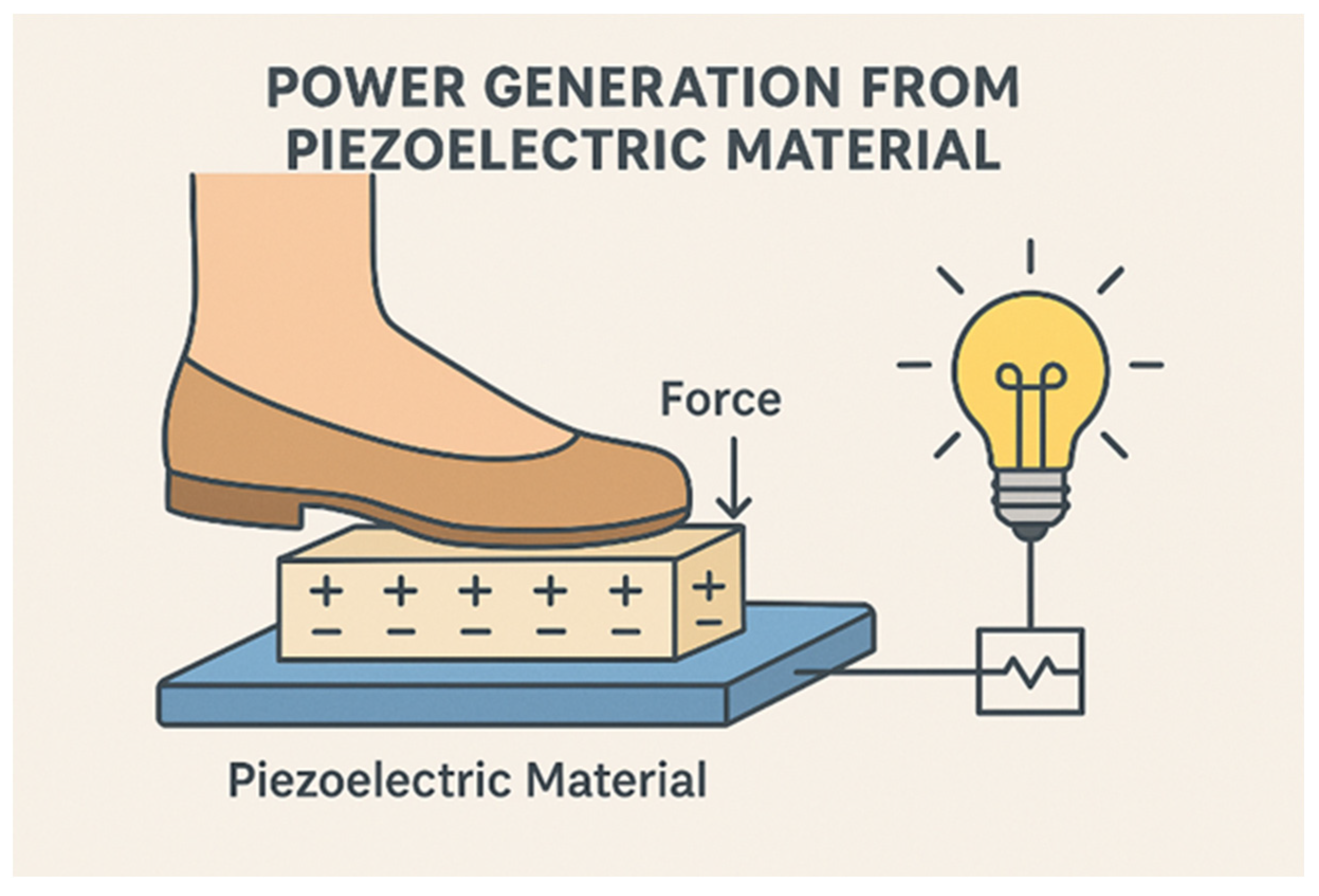



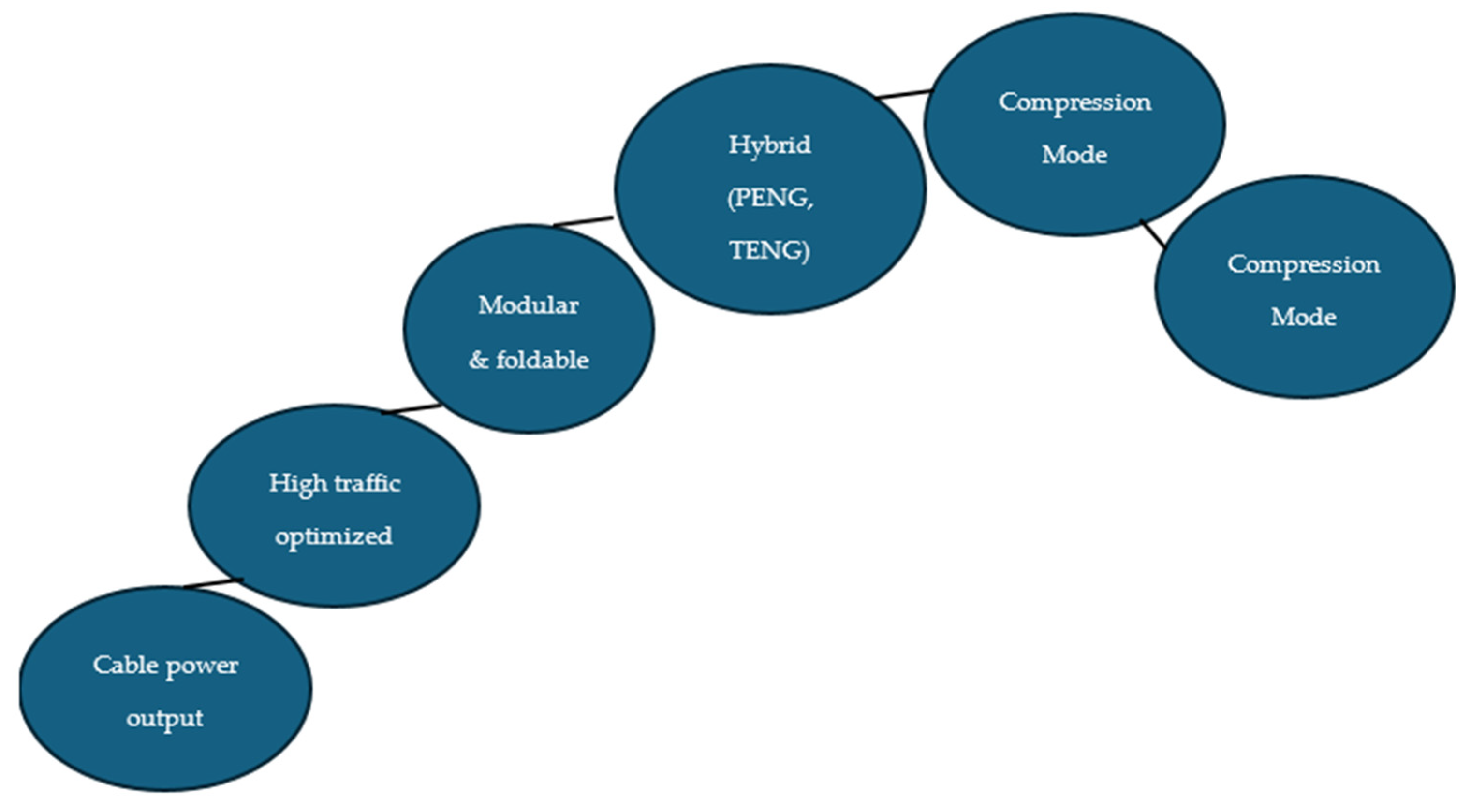


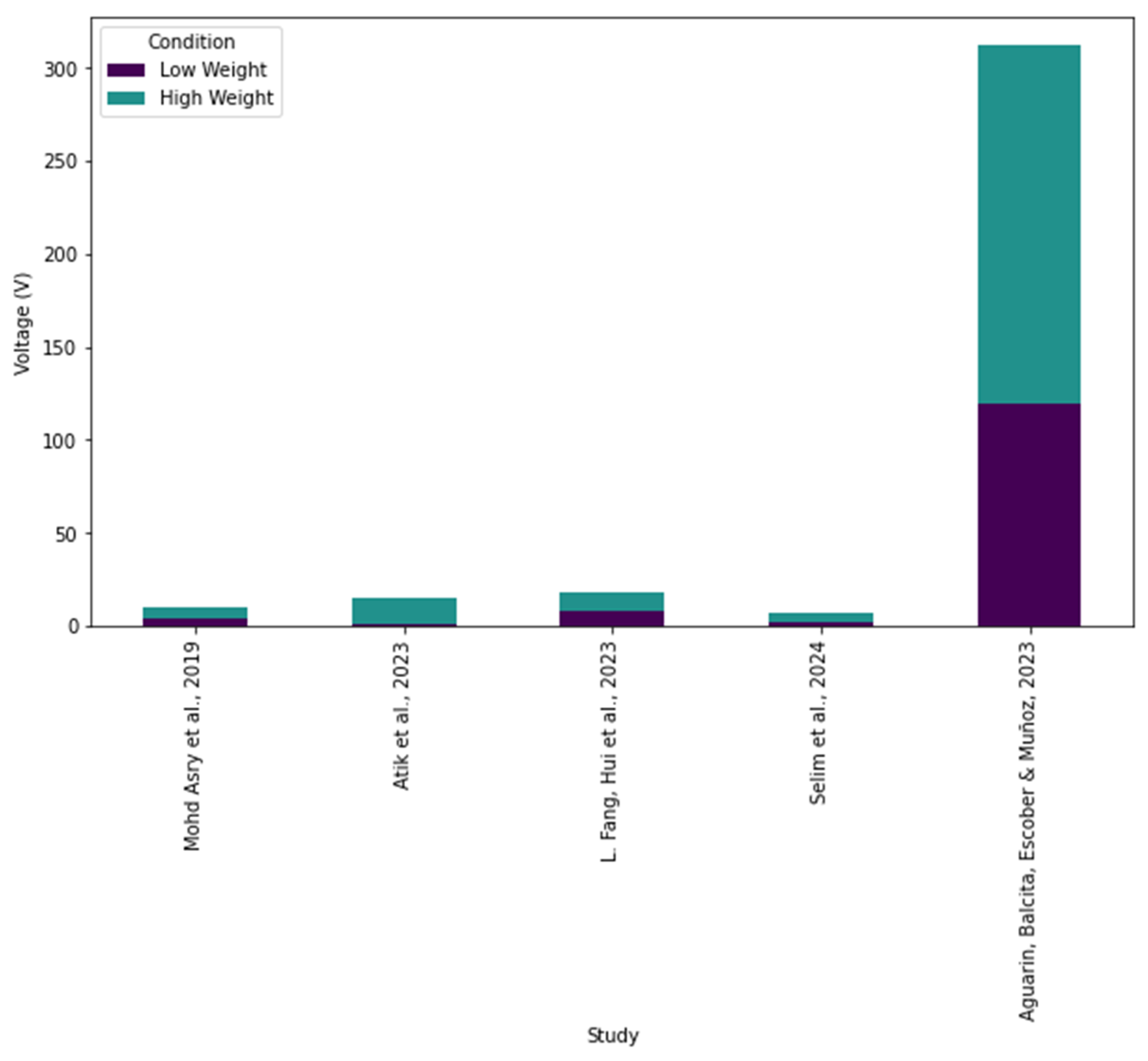
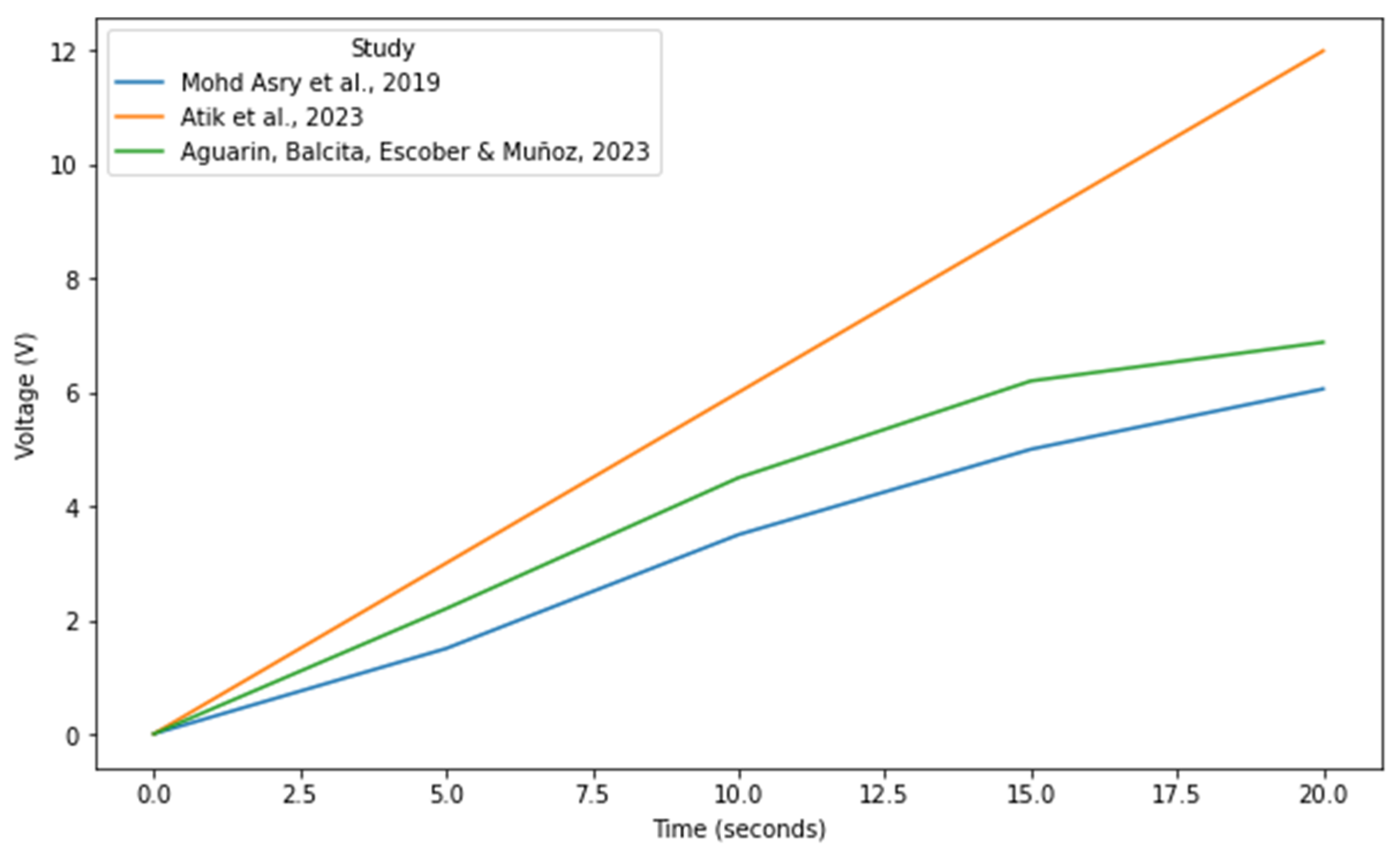
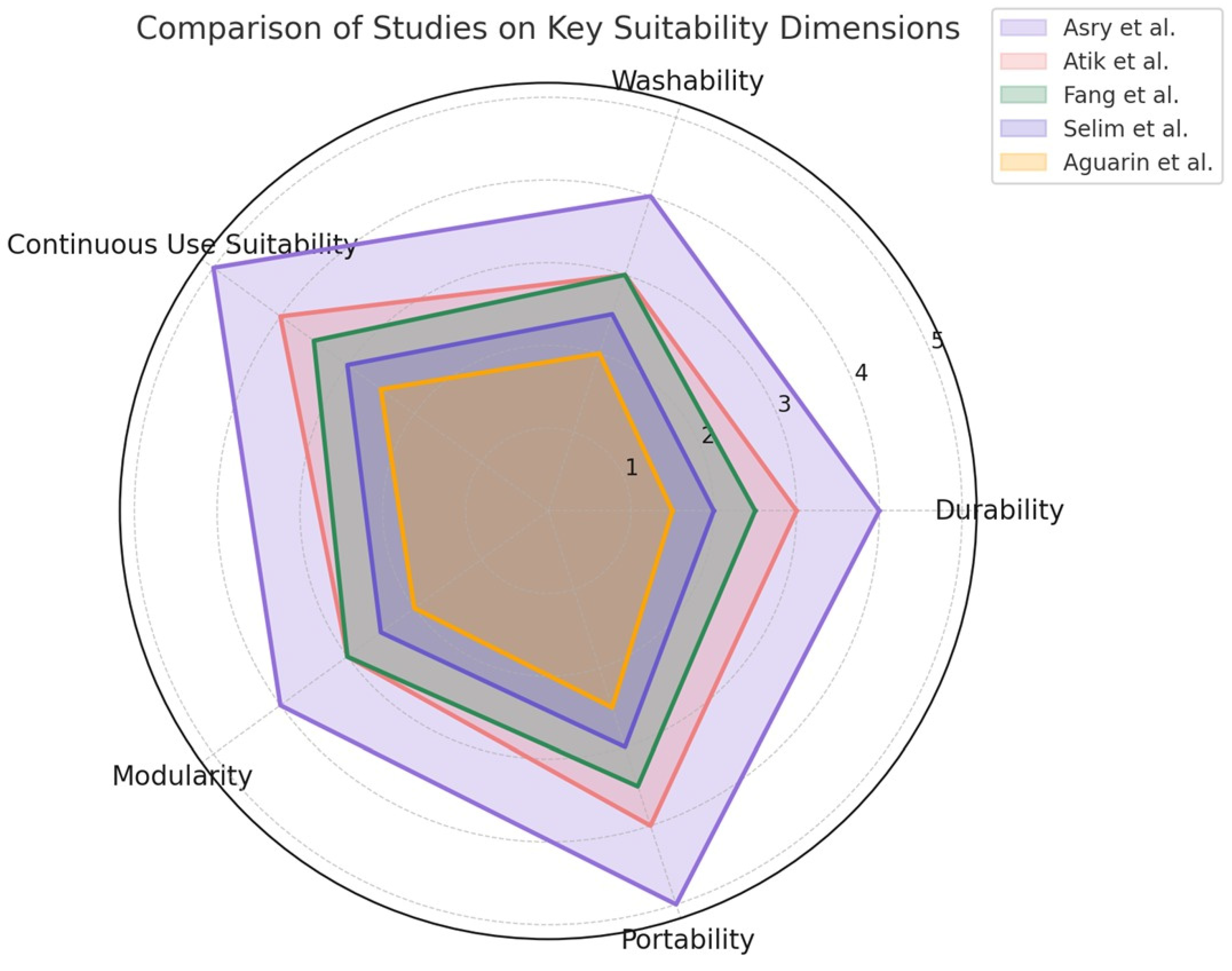
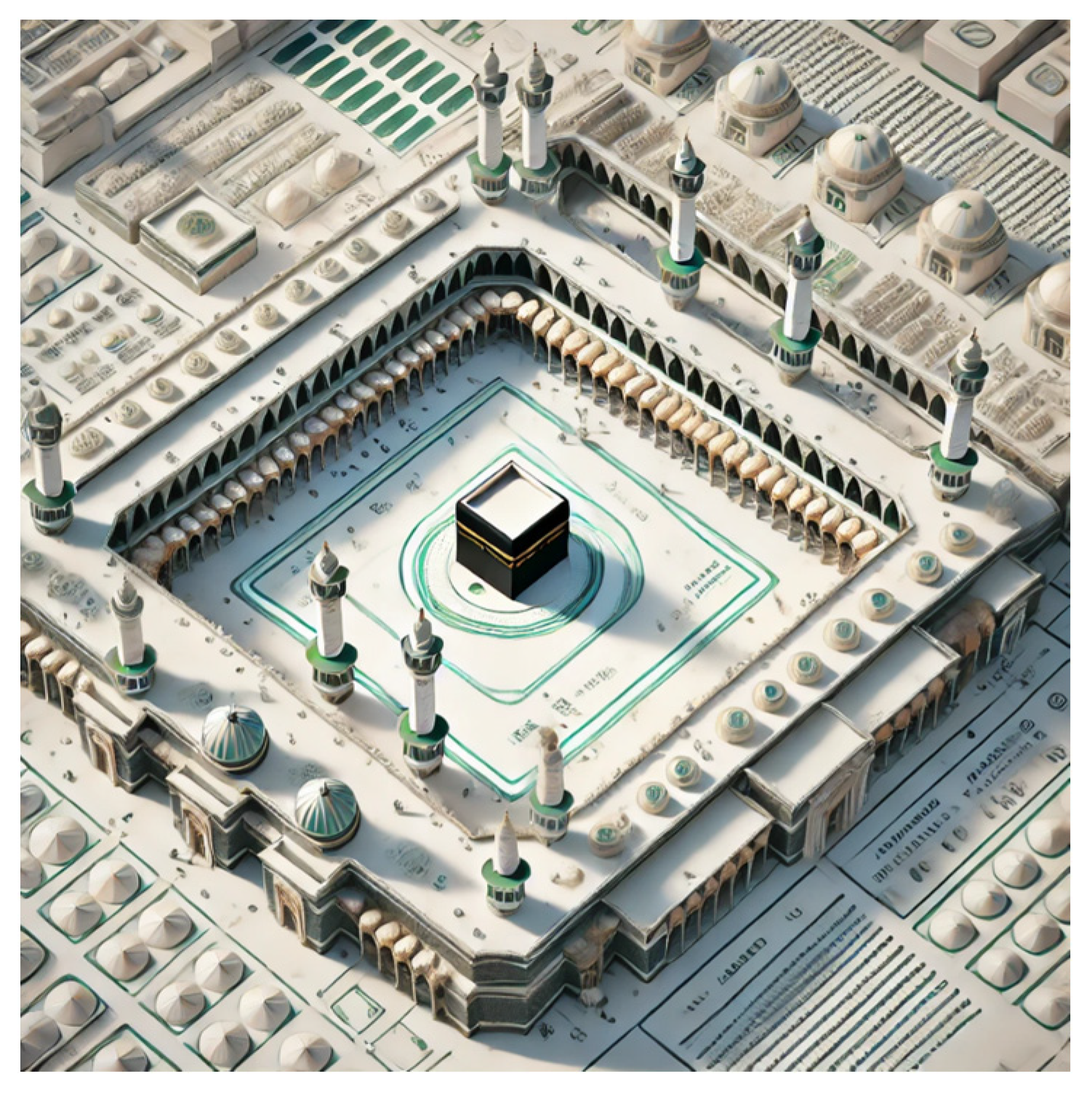
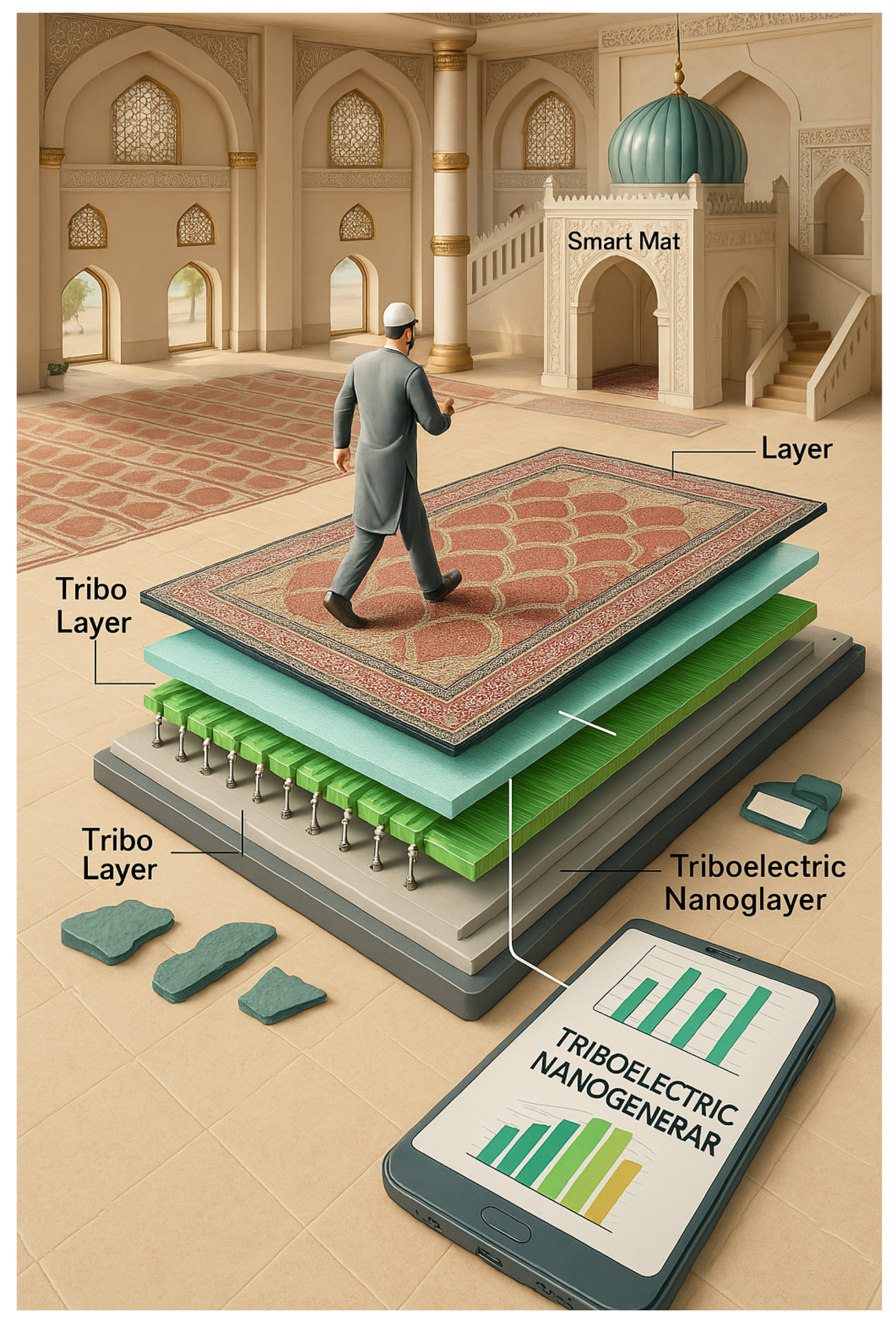
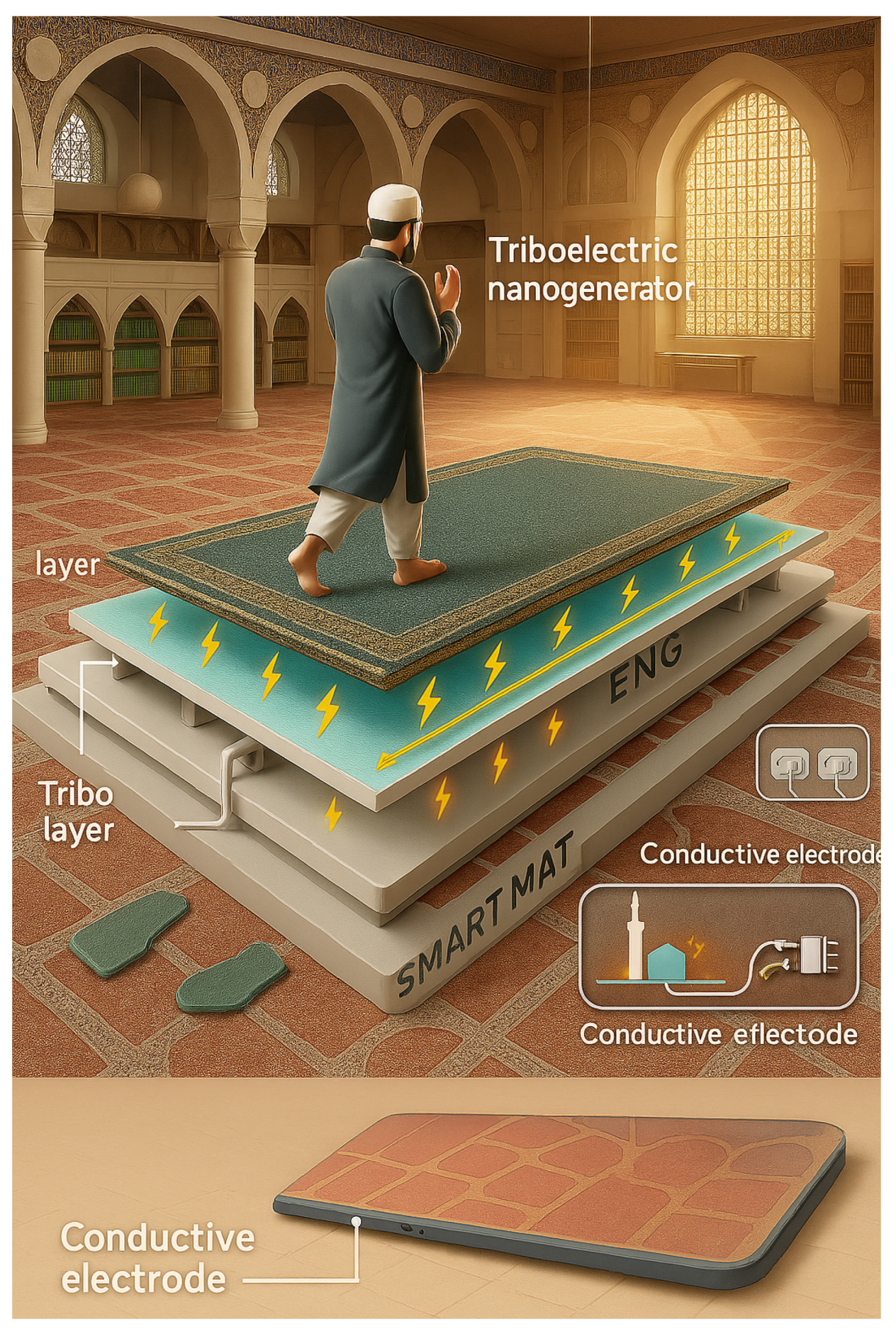
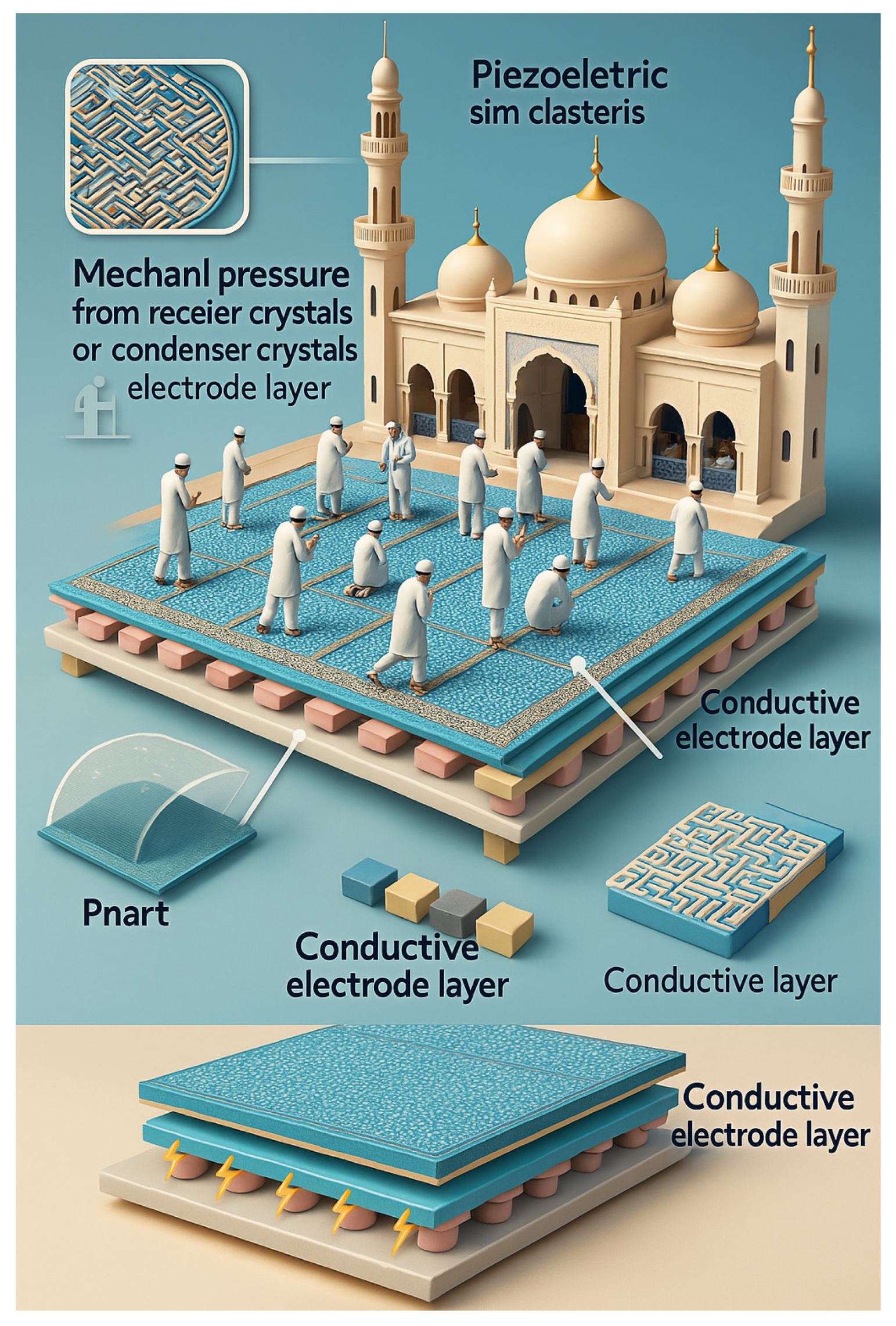
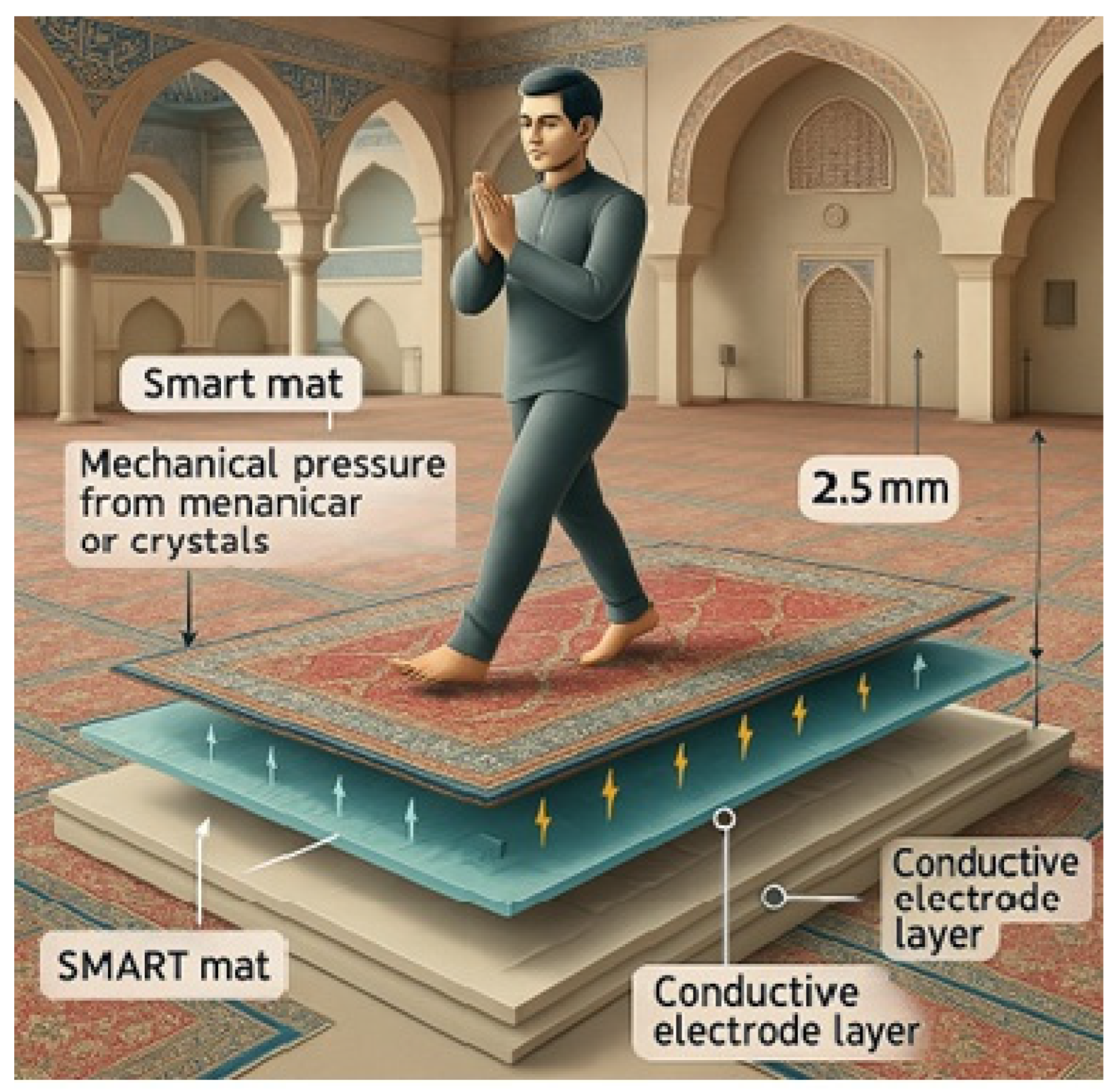
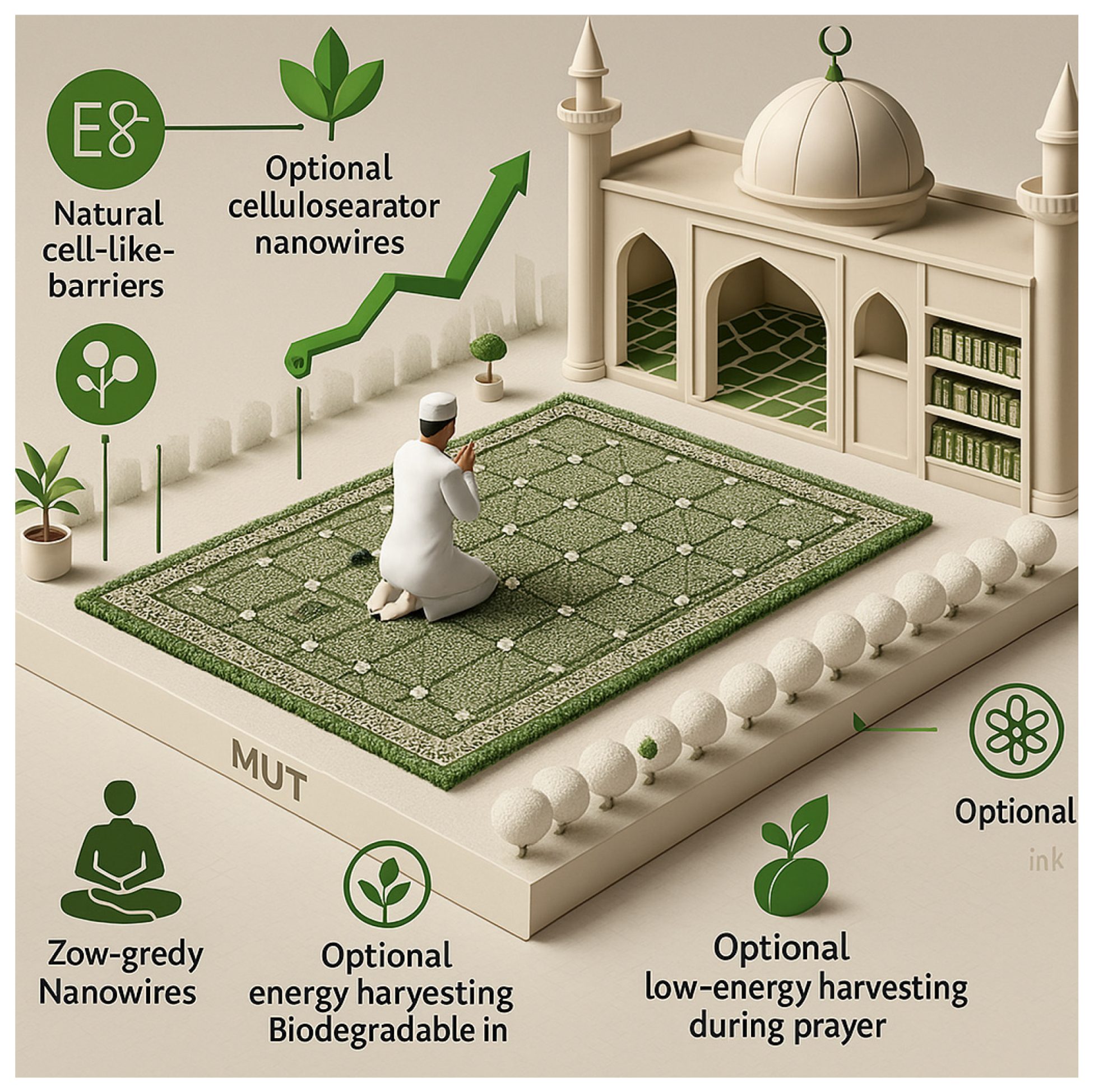
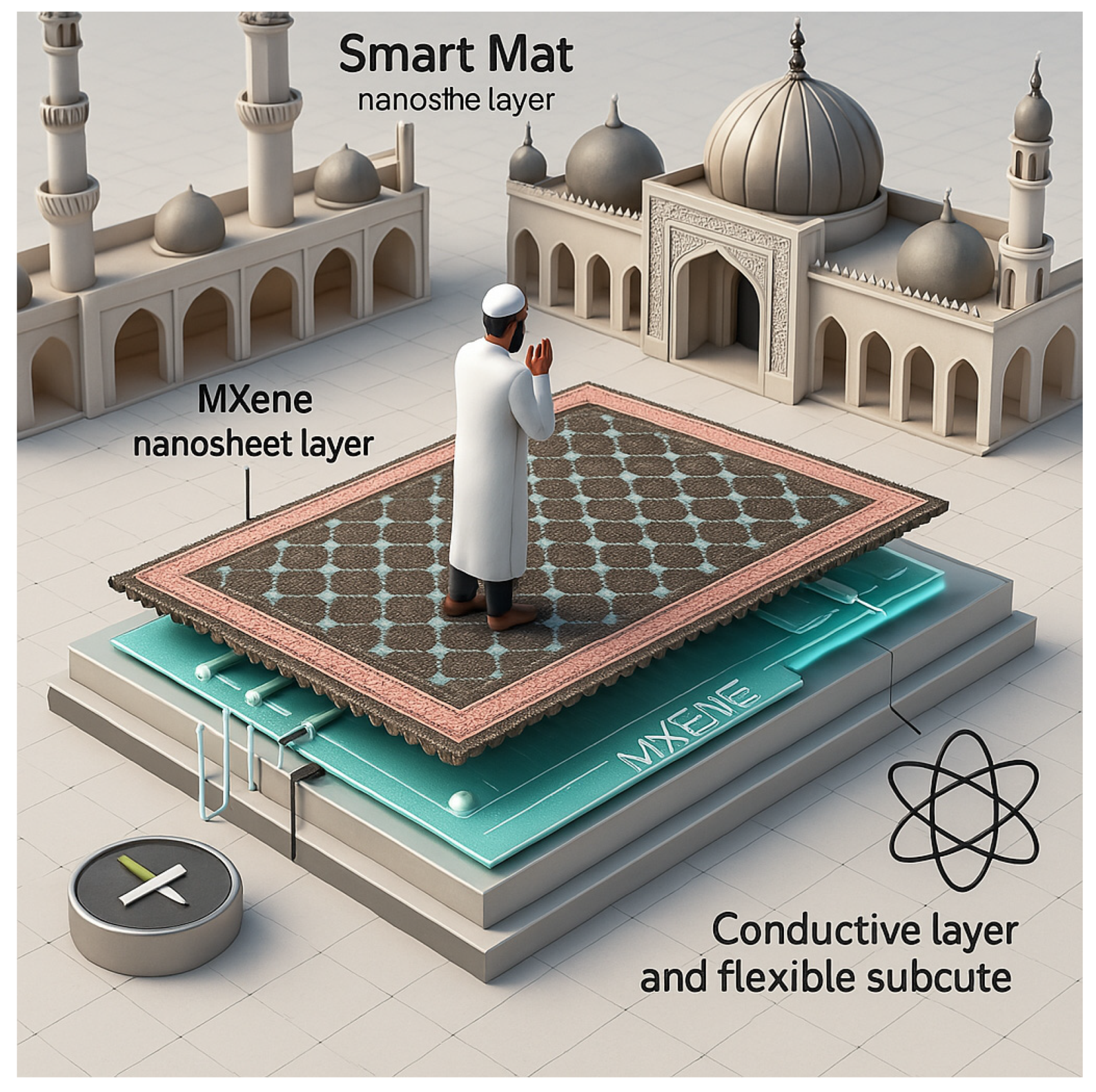

Disclaimer/Publisher’s Note: The statements, opinions and data contained in all publications are solely those of the individual author(s) and contributor(s) and not of MDPI and/or the editor(s). MDPI and/or the editor(s) disclaim responsibility for any injury to people or property resulting from any ideas, methods, instructions or products referred to in the content. |
© 2025 by the authors. Licensee MDPI, Basel, Switzerland. This article is an open access article distributed under the terms and conditions of the Creative Commons Attribution (CC BY) license (https://creativecommons.org/licenses/by/4.0/).
Share and Cite
Alotibi, F.; Khan, M. High Foot Traffic Power Harvesting Technologies and Challenges: A Review and Possible Sustainable Solutions for Al-Haram Mosque. Appl. Sci. 2025, 15, 4247. https://doi.org/10.3390/app15084247
Alotibi F, Khan M. High Foot Traffic Power Harvesting Technologies and Challenges: A Review and Possible Sustainable Solutions for Al-Haram Mosque. Applied Sciences. 2025; 15(8):4247. https://doi.org/10.3390/app15084247
Chicago/Turabian StyleAlotibi, Fatimah, and Muhammad Khan. 2025. "High Foot Traffic Power Harvesting Technologies and Challenges: A Review and Possible Sustainable Solutions for Al-Haram Mosque" Applied Sciences 15, no. 8: 4247. https://doi.org/10.3390/app15084247
APA StyleAlotibi, F., & Khan, M. (2025). High Foot Traffic Power Harvesting Technologies and Challenges: A Review and Possible Sustainable Solutions for Al-Haram Mosque. Applied Sciences, 15(8), 4247. https://doi.org/10.3390/app15084247





